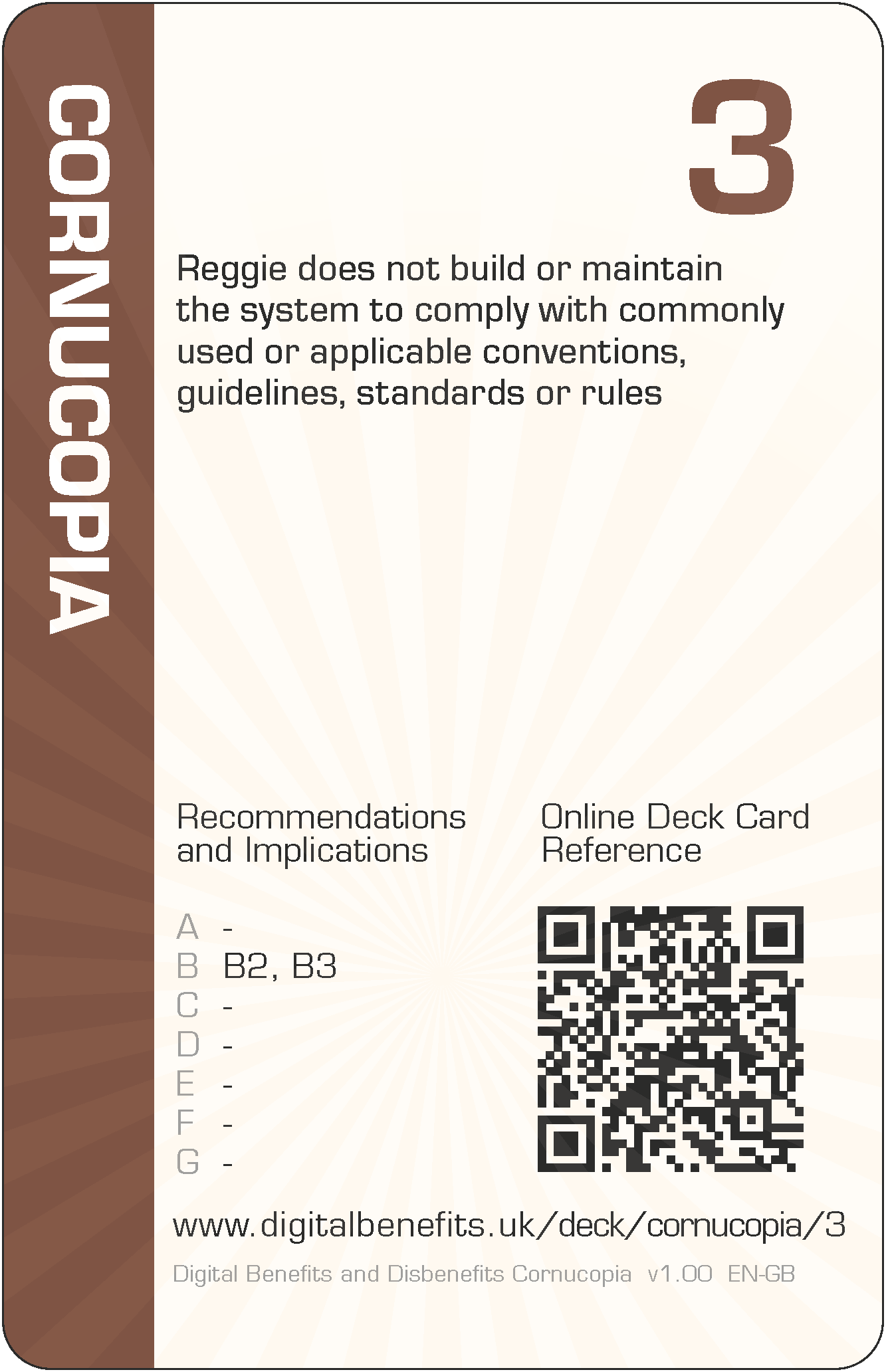Cornucopia 3 (CO-3) Card
DBD Cornucopia > Deck > Cornucopia > 3
Card Details - Three of Cornucopia
Abbreviation
CO-3
Card's focus
The focus of this card is compliance
Threat to claimants
Reggie does not build or maintain the system to comply with commonly used or applicable conventions, guidelines, standards or rules

Threat to claimants
Reggie does not build or maintain the system to comply with commonly used or applicable conventions, guidelines, standards or rules.
Some examples of how this threat could lead to harms (negative effects on claimants)
The design recommendations and implications relevant to the card are listed below in the next section, but even those can be somewhat abstract and difficult to think about during practical day-to-day implementation. Therefore, some example harms are provided to complement the more formal research outputs. These examples are unique per card, and are only published on these web pages (i.e. in no other project outputs).
- The usual attention to usability, availability, accessibility, privacy, and security have not been included leaving claimants unable to access the service, or difficult to use, or at greater risk from malicious people, organisations and bots
- Claimants get confused because the usual website design conventions have been ignored or implemented incorrectly, leading to claimants making additional mistakes and errors, causing claimants to appear incompetent or careless
The examples are to help understand the threat on the card, not to suppress thinking and innovation. Incorporating these examples exactly, or closely matching ones, should be scored down when playing DBD Cornucopia as a game.
Applicable design recommendations and implications
These are reproduced here from Research Briefing N
Acknowledge claimants as people in digital design
- Ensure system and state accountability to claimants
Equalise accountability between claimants and the state. Promote a sense of fairness by enforcing an expectation that service level standards for actions and response times should be similar to those expected of claimants, with related penalties not disproportionately, or only, affecting claimants. Provide tools/methods for claimants to easily check, query and challenge actions and decisions. - Provide clear and configurable communications about process and decision statuses
Use methods proactively, such as internal notifications and external alerts, to help people understand what they need to do/when, and what is in progress by others. Provide confirmations when actions have been completed, information received, decisions made and statuses changed. To accommodate people's individual needs and preferences, provide choices about what, when and how these are re- ceived, who they are sent to and copied to. Offer content options such as whether to have a topic, priority and hyperlink, and ensure it is clear where and how to complete any required action.
General Notes
Card values (i.e. '3' for this card) are for game play and are not correlated with the severity of harm. This is because threats cannot be ranked directly since they can affect individuals in different ways due to situations and circumstances, or affect fewer or more claimants, or the harms can arise in claimants' support networks and wider society.
The threat description uses a person's name as the "attacker" (i.e. 'Reggie' for this card), which can be thought of someone involved with implementation. They could have any role which influence digitisation. So they could be a database administrator, or a copy writer, or a quality assurance specialist, etc, or all of these. Everyone could have some influence on the claimant threat described. The names were randomly selected from those currently most popular as given names for boys and girls (UK Office for National Statistics).
The example harms provided are drawn from the research data (which explored not only parts of existing services but also the effects of possible changes to those), from the author's own knowledge of web application development and testing, the author's own experience of helping citizens to claim Universal Credit (UC) and Personal Independence Payment (PIP), and from suggestions submitted by other people (make a suggestion). The threats and example harms do not necessarily exist in the current UC or PIP deployments or in ecosystems around those services, but they might well do.
All the cards in this Cornucopia suit are: 2 3 4 5 6 7 8 9 10 J Q K A
The other suits in the deck are: Scope, Architecture, Agency, Trust and Porosity (plus Jokers).
